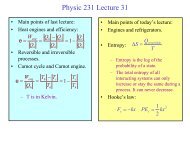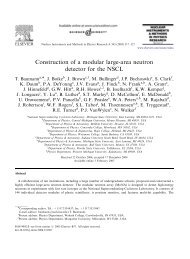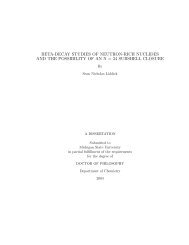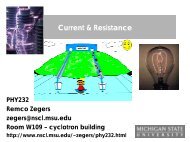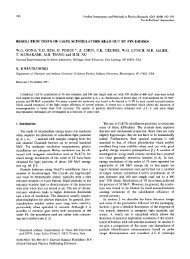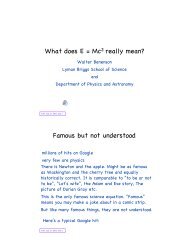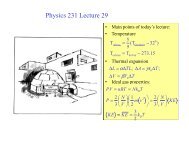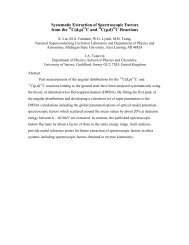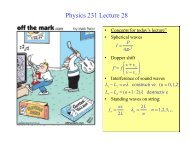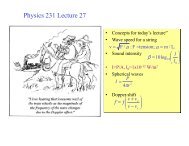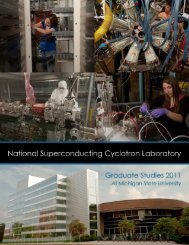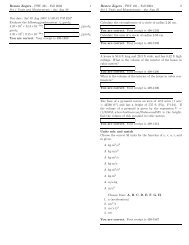Halo Nuclei
Halo Nuclei
Halo Nuclei
Create successful ePaper yourself
Turn your PDF publications into a flip-book with our unique Google optimized e-Paper software.
<strong>Halo</strong> <strong>Nuclei</strong><br />
F. M. Nunes<br />
PAN, July 2005
Nucleus~1/1000 Atom<br />
Nucleon~1/10 Nucleus<br />
Nucleon=proton,neutron<br />
PAN, July 2005
Lifetimes of nuclei<br />
Stable Light nuclei: Z approx. equal to N<br />
(live virtually for ever)<br />
Adding many neutrons brings instability<br />
fineutron dripline<br />
Adding many protons brings instability<br />
fiproton dripline<br />
(very short lifetimes)<br />
PAN, July 2005
the nuclear chart for light nuclei<br />
d<br />
PAN, July 2005
Binding energies of nuclei<br />
Stable Light nuclei: need a lot of energy to break it<br />
(example 4 He=2p+2n E=20 MeV)<br />
neutron dripline: 11 Li E=0.3 MeV<br />
proton dripline: 8 B E=0.1 MeV<br />
Binding energies ~ 100 times smaller<br />
PAN, July 2005<br />
(1 MeV=1.000.000 eV=1.6x10 -13 J)
<strong>Halo</strong> nuclei: sizes<br />
Nuclear force is short range<br />
Nucleus is thought as compact<br />
R = r 0 A 1/3<br />
<strong>Halo</strong> nuclei have a lot of empty space<br />
The relationship for the radius does not hold!<br />
PAN, July 2005
<strong>Halo</strong> nuclei: sizes<br />
Very large spatial extension:<br />
correct asymptotic behaviour needed<br />
finite range effects crucial<br />
PAN, July 2005
<strong>Halo</strong> nuclei and shell model<br />
Traditionally <strong>Nuclei</strong> are thought of as nucleons (neutrons and<br />
protons) packed up in a certain order in shells: Shell Model<br />
A full shell brings increased stability (ex: 4 He): magic numbers!<br />
The halo nucleons sit<br />
typically in a shell of its own<br />
In halo nuclei, magic numbers lose their<br />
magicity! ! And new magic numbers appear…<br />
PAN, July 2005
<strong>Halo</strong> nuclei: simplified spectra<br />
3p+8n<br />
Unbound<br />
states<br />
Neutron dripline<br />
PAN, July 2005<br />
4p+7n<br />
Bound<br />
states<br />
5p+6n<br />
6p+5n<br />
7p+4n<br />
Proton dripline
<strong>Halo</strong> nuclei: resonances<br />
a + A C*<br />
Excitation of resonances<br />
PAN, July 2005
Structure (example for 8 B)<br />
Microscopic<br />
models<br />
mean field,<br />
shell model,<br />
GFMC, SVM,...<br />
Few-body models<br />
three inert bodies or two bodies<br />
Cluster models<br />
(semi-microscopic)<br />
GCM, COSM, ECM,...<br />
PAN, July 2005
<strong>Halo</strong> nuclei and Quantum Mechanics<br />
A nucleon inside a nucleus is characterized by its wave function Y.<br />
ψ<br />
The probability of finding<br />
the nucleon at r is | Y(r) 2 |.<br />
V<br />
V<br />
ψ<br />
ψ<br />
As one adds many<br />
neutrons to a<br />
nuclear system<br />
the potential well<br />
gets shallower and<br />
the wavefunction<br />
extends radially<br />
PAN, July 2005
Deuteron: the first halo nucleus<br />
D=n+p<br />
Binding energy 2.2 MeV<br />
Spatial extension of 4 fm<br />
E<br />
u(r) = rψ<br />
R<br />
–E B<br />
V(r)<br />
PAN, July 2005<br />
Nuclear potential is repulsive at short distances<br />
The n-p sit at distances much larger than<br />
the range of the nuclear interaction
<strong>Halo</strong> nuclei and density distributions<br />
| Y(r) 2 |<br />
density (fm -3 ) density (fm -3 )<br />
0.1<br />
0.075<br />
0.05<br />
0.025<br />
0<br />
18 C core<br />
19<br />
C<br />
(a)<br />
(b)<br />
10 -1<br />
10 -3<br />
halo neutron<br />
10 -5<br />
10 -7<br />
0 5 10 15 20<br />
radius (fm)<br />
Calculated particle density distributions (H. Lenske).<br />
PAN, July 2005
<strong>Halo</strong> nuclei and Quantum Mechanics<br />
Heisenberg’s uncertainty principle:<br />
dx dv > ћ/2m<br />
large spatial extension Æ narrow velocity distribution!<br />
Probability of finding the<br />
nucleon at r is | Y(r) 2 | .<br />
Probability of finding the nucleon<br />
with velocity v is | Y(v) 2 | .<br />
x<br />
p<br />
v<br />
PAN, July 2005
<strong>Halo</strong> nuclei and Momentum distributions<br />
Large radii<br />
PAN, July 2005<br />
Narrow momentum distributions
Borromean <strong>Halo</strong> nuclei<br />
Some halo nuclei have lighter neighboring isotopes<br />
that are unbound giving rise to a peculiar situation:<br />
If you remove either one of the two neutrons or the<br />
core, the remaining subsystem is unbound!<br />
10<br />
Li= 9 Li+n unbound<br />
n+n is unbound<br />
But 11 Li is bound!<br />
9<br />
Li<br />
n<br />
Borromean rings<br />
n<br />
PAN, July 2005
the nuclear chart for light nuclei<br />
d<br />
PAN, July 2005
<strong>Halo</strong> nuclei: what are the present interests?<br />
nuclear moments and electric moments<br />
excited states: resonances<br />
transition strengths between states<br />
where is the dripline<br />
discover new heavier haloes<br />
precision (in particular for Nuclear-Astrophysics)<br />
We want to know the details!<br />
PAN, July 2005
<strong>Halo</strong> nuclei: what are our tools?<br />
Reactions!!!<br />
elastic scattering<br />
inelastic scattering<br />
breakup<br />
transfer reactions<br />
knockout reactions<br />
fusion reactions<br />
…<br />
PAN, July 2005
<strong>Halo</strong> nuclei: elastic scattering<br />
PAN, July 2005
<strong>Halo</strong> nuclei: elastic scattering<br />
PAN, July 2005
<strong>Halo</strong> nuclei: elastic scattering<br />
PAN, July 2005
<strong>Halo</strong> nuclei: elastic scattering<br />
PAN, July 2005
<strong>Halo</strong> nuclei: elastic scattering<br />
PAN, July 2005
<strong>Halo</strong> nuclei: elastic scattering<br />
PAN, July 2005
<strong>Halo</strong> nuclei: elastic scattering<br />
PAN, July 2005
<strong>Halo</strong> nuclei: breakup<br />
PAN, July 2005
<strong>Halo</strong> nuclei: breakup<br />
PAN, July 2005
<strong>Halo</strong> nuclei: breakup<br />
PAN, July 2005
<strong>Halo</strong> nuclei: breakup<br />
PAN, July 2005
<strong>Halo</strong> nuclei: breakup<br />
PAN, July 2005
<strong>Halo</strong> nuclei: breakup<br />
PAN, July 2005
<strong>Halo</strong> nuclei: transfer<br />
PAN, July 2005
<strong>Halo</strong> nuclei: transfer<br />
PAN, July 2005
<strong>Halo</strong> nuclei: transfer<br />
PAN, July 2005
<strong>Halo</strong> nuclei: transfer<br />
PAN, July 2005
<strong>Halo</strong> nuclei: transfer<br />
PAN, July 2005
<strong>Halo</strong> nuclei: transfer<br />
PAN, July 2005
<strong>Halo</strong> nuclei: fusion<br />
PAN, July 2005
<strong>Halo</strong> nuclei: fusion<br />
PAN, July 2005
<strong>Halo</strong> nuclei: fusion<br />
PAN, July 2005
<strong>Halo</strong> nuclei: fusion<br />
PAN, July 2005
<strong>Halo</strong> nuclei: fusion<br />
PAN, July 2005
<strong>Halo</strong> nuclei: what are our tools?<br />
Reactions!!!<br />
Reactions<br />
elastic scattering<br />
inelastic scattering<br />
breakup<br />
transfer reactions<br />
knockout reactions<br />
fusion reactions<br />
Structure<br />
PAN, July 2005
<strong>Halo</strong> nuclei: future<br />
Are there any<br />
heavy halos?<br />
PAN, July 2005
The end<br />
Questions?<br />
PAN, July 2005
Magic numbers and excitation energies<br />
PAN, July 2005<br />
Magic nuclei have very high first excited states energies<br />
(Alex Brown)
Dripline nuclei and Astrophysics<br />
PAN, July 2005<br />
R-process abundance (Moller, Nix and Kratz)



